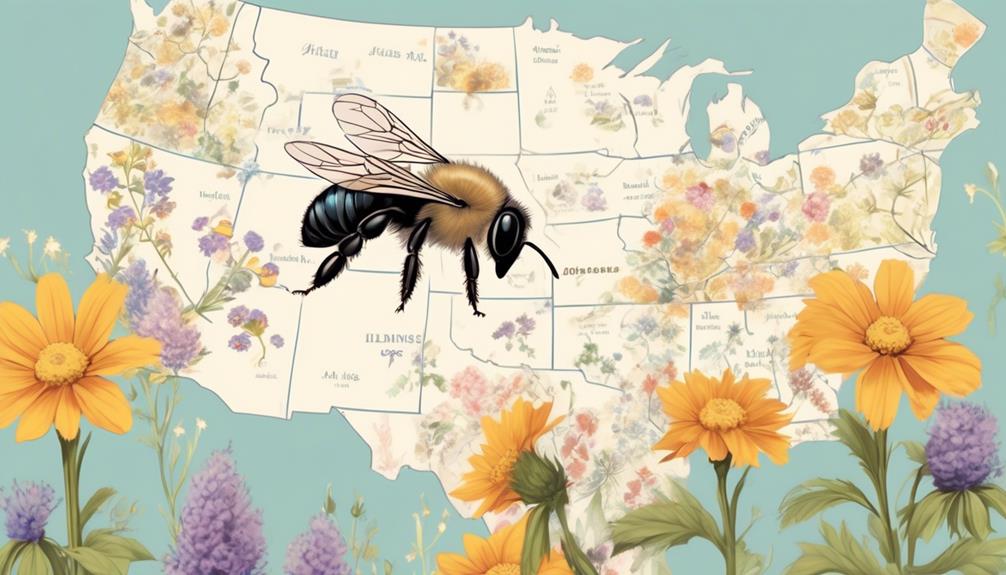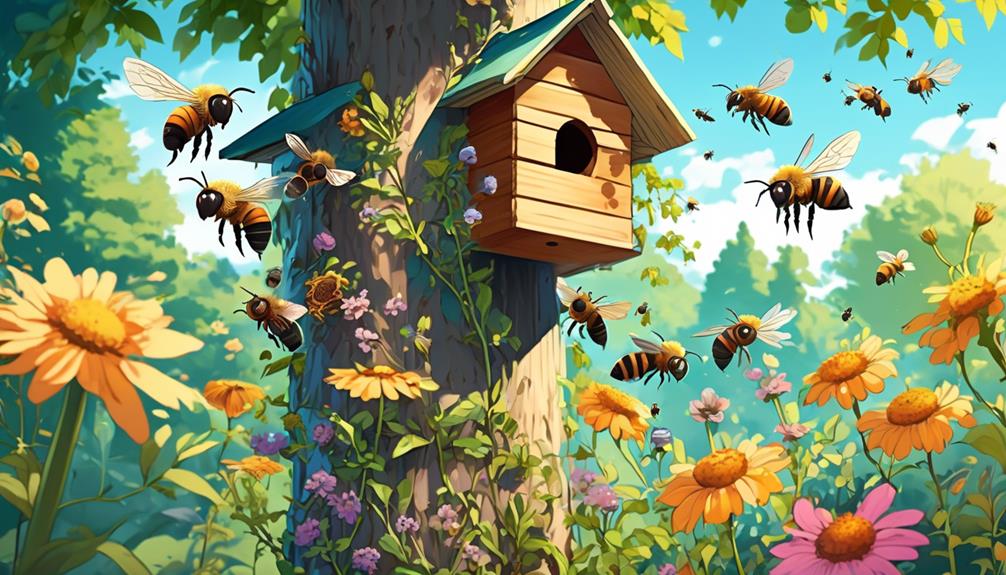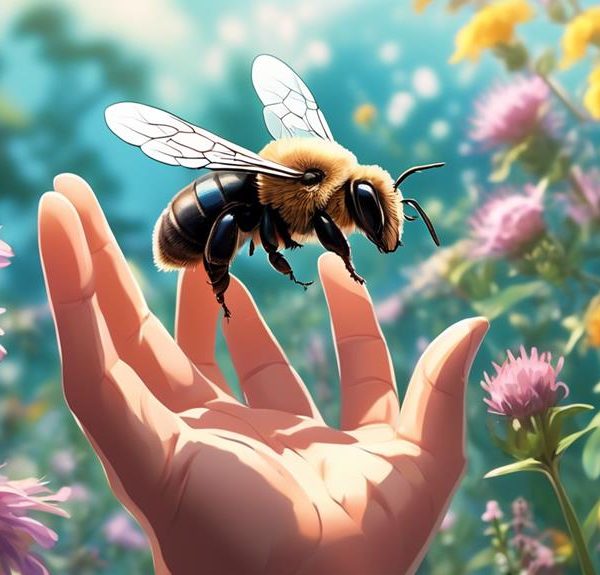P'onder the prevalence of Mason bees in Illinois and explore their significant role in the ecosystem with this intriguing study.

Are Mason Bees Common in Illinois
Channeling the curiosity of Charles Darwin, you might find yourself wondering about the prevalence of Mason bees in the state of Illinois. After all, these little creatures play a pivotal role in our ecosystems, particularly in the pollination of our plants and crops.
You're likely aware that bees, in general, are widespread, but what about Mason bees specifically? Are they as common as we think, or is their presence in the Prairie State more of a rarity?
Stick around, as we're about to embark on a fascinating exploration of these intriguing insects.
Key Takeaways
- Mason Bees are non-aggressive and rarely sting, making them suitable for urban and suburban environments in Illinois.
- Mason Bees play a vital role in Illinois' ecosystem by ensuring plant pollination.
- Mason Bees have adapted to diverse climates in Illinois, tolerating both northern chill and southern heat.
- Threats to Mason Bees in Illinois include habitat loss, climate change, and pesticide use.
Understanding Mason Bees

To truly appreciate the role of Mason Bees in Illinois' ecosystem, you need to delve into an understanding of their unique biology and behavior. Unlike honeybees, Mason Bees are solitary creatures. Each female is a queen, laying her eggs in individual cells she's carefully crafted out of mud. Hence, the name 'Mason'.
These bees are non-aggressive and rarely sting, making them perfect for urban and suburban environments. They're also stellar pollinators. You'll often find them buzzing around fruit trees and other early spring bloomers, their bodies dusted with pollen.
Interestingly, Mason Bees have a different approach to pollination than honeybees. They practice something called 'belly flopping', where they sort of roll around in the flower, collecting pollen on their belly. This method is quite effective, enabling them to pollinate more flowers in a shorter span of time.
While they don't produce honey, their role in Illinois's ecosystem is vital. By ensuring the pollination of plants, they contribute to biodiversity and the survival of various plant species. Understanding their biology and behavior helps you appreciate their essential role in the ecosystem.
Mason Bees' Adaptability to Illinois

Despite their small size, Mason Bees have remarkably adapted to Illinois' diverse climates, braving both the chill of the northern regions and the heat of the south with equal fortitude. They've evolved to tolerate temperature extremes, making them a resilient pollinator species across the state.
Mason Bees' adaptability doesn't stop at weather conditions. They've also learned to exploit a variety of nesting habitats. You'll find them in hollow stems, decaying wood, and even in the cracks of your home's exterior. Their ability to adapt to different environments is a testament to their resourcefulness and survivability.
Their feeding habits also display this adaptability. They aren't picky eaters; they'll visit a wide range of flowers for pollen and nectar. They've been spotted on native plants, garden blooms, and even invasive species. Their dietary flexibility ensures they can find food in various landscapes, from bustling urban gardens to serene prairies.
Importance of Mason Bees in Illinois

Given their exceptional adaptability, it's no surprise that Mason Bees play a pivotal role in Illinois' ecosystem. These tiny powerhouses are vital for plant pollination, aiding in the propagation of various native plant species. Mason Bees are solitary bees, meaning they don't live in hives like honeybees. Instead, you'll find them in pre-existing cavities such as hollow stems or holes in wood.
Due to their unique pollination style, Mason Bees can pollinate more effectively than many other bee species. They carry pollen on their undersides, allowing for easy transfer between flowers. This makes them key contributors to your local gardens and farms.
Without Mason Bees, the productivity of crops and growth of wildflowers might suffer. They're essential for the survival of many plants, which in turn, create habitats for other creatures and maintain biodiversity. Moreover, they pose minimal risk to humans as they're non-aggressive and rarely sting.
Threats to Mason Bees in Illinois

Facing a variety of threats, Mason Bees in Illinois are under increasing pressure from habitat loss, climate change, and the use of pesticides. You might wonder, 'How serious are these threats?' Well, let's break it down.
Threat | Impact |
|---|---|
Habitat Loss | Urban development and agricultural practices are reducing the availability of nesting sites for Mason Bees. |
Climate Change | Changes in seasonal patterns disrupt the lifecycle of Mason Bees, affecting their emergence, reproduction, and survival. |
Pesticides | Exposure to pesticides, particularly neonicotinoids, can lead to impaired reproduction, reduced lifespan, and even death. |
Habitat loss is perhaps most immediate, with urban development and farming practices often destroying the natural sites these bees use for nesting. Climate change, meanwhile, is a more insidious threat. Shifts in temperature and precipitation patterns can disrupt the lifecycle of Mason Bees, causing them to emerge at the wrong time and struggle to find food. Pesticides pose a diverse range of threats, from impairing the bees' reproductive capabilities to reducing their lifespan and, in the worst cases, causing immediate death. These threats are interconnected, compounding the challenges Mason Bees face in Illinois.
Encouraging Mason Bees' Presence

Boosting the population of Mason Bees in Illinois requires concerted efforts. This includes providing suitable habitats, reducing pesticide exposure, and raising awareness about their ecological significance.
To create an appealing environment for these pollinators, you can install bee houses. It is important to use untreated, unpainted wood for the bee houses, as Mason Bees prefer this. Additionally, providing ample sources of nectar and pollen throughout the flowering season is crucial.
In order to protect Mason Bees, it is essential to avoid the use of pesticides in your garden. These chemicals can be extremely harmful to bees and can negatively impact their populations.
Raising awareness about the ecological significance of Mason Bees is also crucial. These bees play a vital role in pollination, contributing significantly to biodiversity and the health of local ecosystems. To do your part, you can educate others about the importance of Mason Bees and share tips on how to attract them. Additionally, advocating for policies that protect Mason Bees can make a difference in their conservation efforts.
Frequently Asked Questions
What Are the Main Differences Between Mason Bees and Other Common Bees Like Honeybees or Bumblebees?
You're asking about the key differences between mason bees and more common bees like honeybees or bumblebees.
Mason bees are solitary, unlike honeybees which live in hives. They're also more efficient pollinators.
Mason bees carry pollen on their belly, while honeybees and bumblebees carry it on their hind legs.
Plus, while honeybees make honey, mason bees don't.
They're named for their habit of using mud to build nest partitions, like a mason.
How Can I Identify a Mason Bee if I Spot One in My Garden?
To identify a Mason bee in your garden, you'll need to look for specific features. They're typically small, metallic blue or green, and don't have the 'furry' appearance of honeybees or bumblebees.
You'll also notice they're solitary, not living in hives like other bees.
Additionally, check for nesting habits. Mason bees use mud to seal off their nests, usually in hollow stems or pre-existing holes.
Are There Any Specific Plants or Flowers That Attract Mason Bees?
Yes, there are specific plants that attract Mason bees. You'll find them buzzing around flowering plants, especially those native to your area. They're particularly drawn to fruit trees and spring-blooming shrubs.
Mason bees also love herbs like lavender, sage, and rosemary. Plant these in your garden, and you're likely to see these beneficial pollinators.
It's crucial to avoid pesticides though, as they can harm the bees.
Can Mason Bees Sting or Pose a Threat to Humans or Pets?
Yes, Mason bees can sting, but they're not aggressive and typically sting only if threatened. They don't pose a significant threat to humans or pets. In fact, their stings are less painful than a mosquito bite.
Unlike honey bees, Mason bees can sting multiple times, but they rarely do. They're beneficial insects, pollinating plants more effectively than honey bees.
Do Mason Bees Have Any Predators in Illinois, and if So, Which Ones?
Yes, Mason bees in Illinois do face threats from predators. Birds, spiders, and small mammals may prey on the bees. They're also vulnerable to parasitic insects like wasps which can lay their eggs in Mason bee nests.
Additionally, certain fungi and bacteria can infect and kill these bees. It's important to maintain a healthy habitat for them to minimize these risks.
Conclusion
So, you've learned that mason bees are indeed common in Illinois. You've seen their adaptability, understood their importance, and recognized the threats they face.
It's clear that these little pollinators play a critical role in our ecosystem. Let's do our part in promoting healthy habitats for them, for they aren't just beneficial, they're essential.
Remember, every small step you take towards encouraging mason bees' presence makes a big difference.



